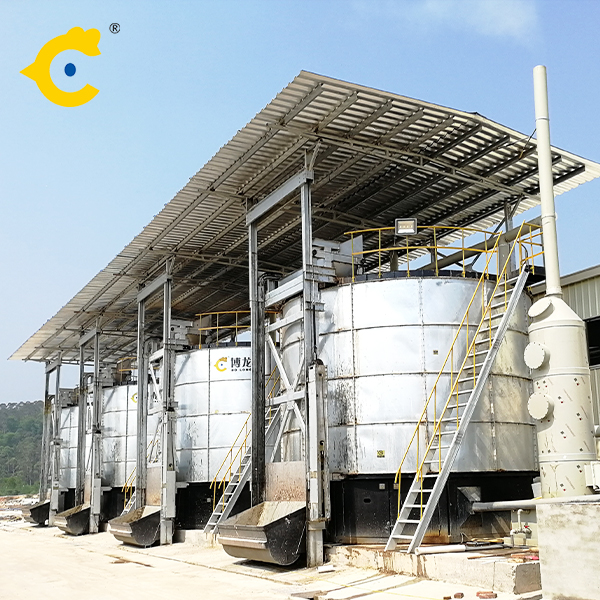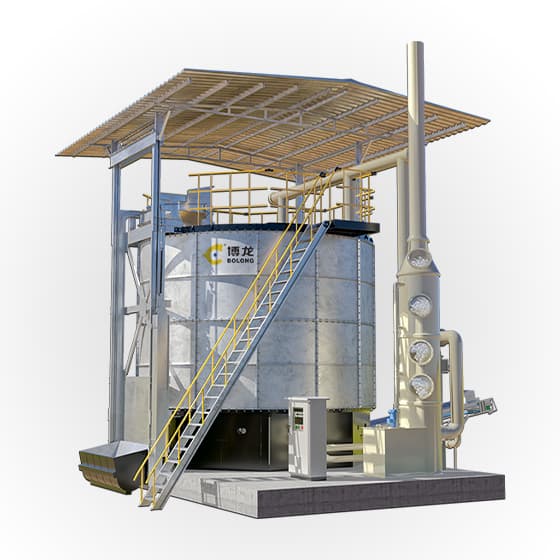With the continuous improvement of global environmental awareness, the demand for treating organic waste is increasing. As an efficient and environmentally friendly organic waste treatment equipment, high temperature aerobic fermentation tank is gradually becoming the preferred solution for various industries. It converts waste into high-quality organic fertilizer by controlling temperature and oxygen supply, which not only reduces the impact of landfill on the environment, but also opens up a new way for resource recycling.

Aerobic fermentation is a process in which microorganisms metabolize, decompose and release energy using organic matter as a source of nutrition under aerobic conditions. This process is particularly common in fermentation tanks, especially when treating organic waste. Aerobic fermentation in fermentation tanks enables microorganisms to grow and reproduce rapidly by providing sufficient oxygen and suitable temperature, and converts waste into high-quality organic fertilizer.
In the aerobic fermentation process, the supply of oxygen is one of the key factors. The metabolic activities of microorganisms require sufficient oxygen to maintain their life activities and the decomposition of organic matter. When there is insufficient oxygen, the fermentation process becomes unstable and even turns to anaerobic fermentation, producing harmful gases such as methane. The gas delivery system in the fermentation tank can ensure the uniform distribution of oxygen, making the entire fermentation process more efficient and safe.
Temperature is also an important factor affecting aerobic fermentation. Usually, aerobic fermentation in the fermentation tank is controlled under high temperature conditions. This high temperature environment not only accelerates the reproduction of microorganisms, but also effectively kills harmful pathogens and parasites, thereby ensuring the safety and quality of the final product. Generally speaking, the ideal fermentation temperature range is between 50°C and 65°C, when the activity of microorganisms is the strongest and the efficiency of decomposing organic matter is the highest.
Bolong fermentation tank is an advanced equipment for efficient treatment of organic waste. It is widely used in the treatment of different types of organic waste such as livestock and poultry manure, livestock and poultry carcasses, kitchen waste, and urban sludge. The core feature of Bolong fermentation tank is the high-temperature aerobic fermentation process, which efficiently converts these wastes into organic fertilizers, helping the circular economy and sustainable development.
The operating principle of Bolong fermentation tank is to use microorganisms to decompose organic matter in an aerobic environment to generate heat, carbon dioxide and water vapor. The equipment adopts a vertical tank body, so that organic waste can be evenly distributed under the action of gravity. Compared with traditional fermentation equipment, the Bolong fermentation tank does not need to add any auxiliary materials. It only needs to ensure that the moisture content of the organic waste is kept below 70%, and it can be directly put into the tank for fermentation.
Another major advantage of the Bolong fermentation tank is its ability to operate continuously. New organic waste can be put into the tank every day. After about 7 days of fermentation, the organic waste will be converted into high-quality organic fertilizer. The fermentation tank is equipped with a bucket elevator, which can automatically lift the organic waste and put it into the tank, reducing the complexity of manual operation and improving the processing efficiency. The stirring blades in the tank are constantly running, so that the organic waste is fully stirred and mixed, ensuring the uniform distribution of oxygen during the fermentation process.
The Bolong fermentation tank is also equipped with a special heat exchange system, which uses the waste gas heat generated during the fermentation process to preheat the fresh air entering the tank. This waste heat recovery mechanism not only effectively saves energy consumption, but also accelerates the fermentation process. The warm air is evenly distributed through the air circulation system in the tank, which promotes the rapid degradation of organic waste and accelerates the evaporation of water. This system can ensure that the fermentation tank continues to operate in a high temperature environment, so that the microbial activity reaches the best state, and the yield and quality of organic fertilizer are improved.
Bolong fermentation tanks are regarded as sophisticated organic waste treatment equipment and have remarkable potential and practical significance in relation to the environment. Given the increasing global consciousness concerning our environment and the ongoing rise in waste disposal standards in other regions of the world, Imposing traditional waste disposal methods of landfilling and burning can no longer be got around. In this light, Bolong Fermentation Tanks have become a successful method in the acclamation of aerobic fermentation with efficient organic waste disposal.
To start with, there is an emphasis on the importance of Bolong Fermentation Tanks in agriculture and animal husbandry. It can process bulk quantity of livestock and poultry waste and also cadavers. Through intensive aerobic fermentation at high temperatures, pollutants from such wastes to the environment are minimized and valuable organic fertilizers are obtained from the wastes instead. Such organic fertilizers can enhance soil more than chemical ones thus minimizing chemical pollution in agricultural practices and encouraging green agriculture. Our fermentation tanks have good marketing potentials in this area and have been sold to more than thirty countries meeting the needs of farmers around the globe.
Secondly, in the field of urban waste treatment, Bolong Fermentation Tanks also play an important role. Kitchen waste and urban sludge are the main components of urban waste. They are easy to rot, stink, and difficult to degrade naturally. Bolong fermentation tanks can efficiently process these organic wastes, eliminate odors, and convert them into useful resources, reducing the pressure on landfills. Our company cooperates with municipal projects to assist in the construction of sewage treatment plants, etc. By recycling the energy in waste, Bolong fermentation tanks provide strong support for the sustainable development of cities.

In short, Bolong fermentation tanks have become one of the key technologies to promote circular economy and green environmental protection with their excellent organic waste treatment capabilities and environmental performance. Whether in agriculture, animal husbandry, or urban waste treatment, the wide application of Bolong fermentation tanks has made positive contributions to achieving environmental sustainability goals. If you are interested, please contact us!